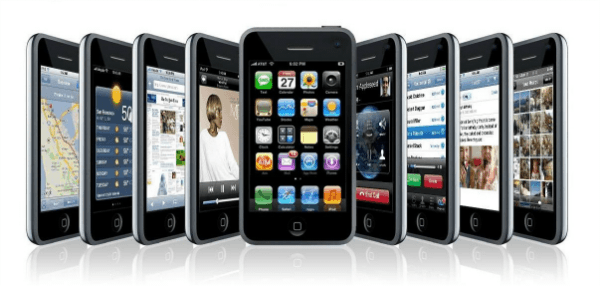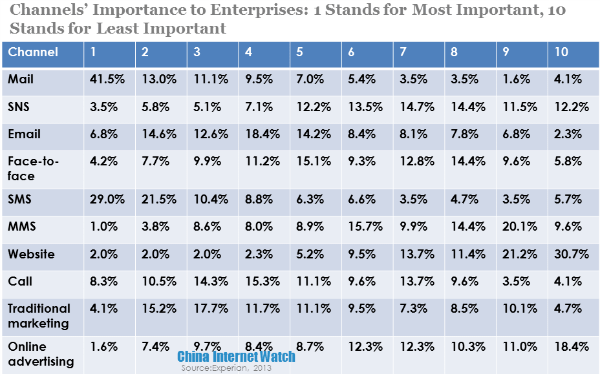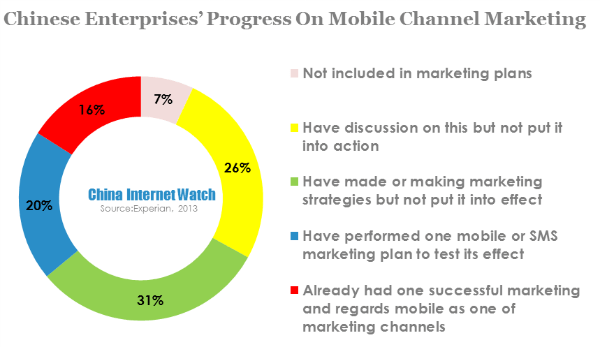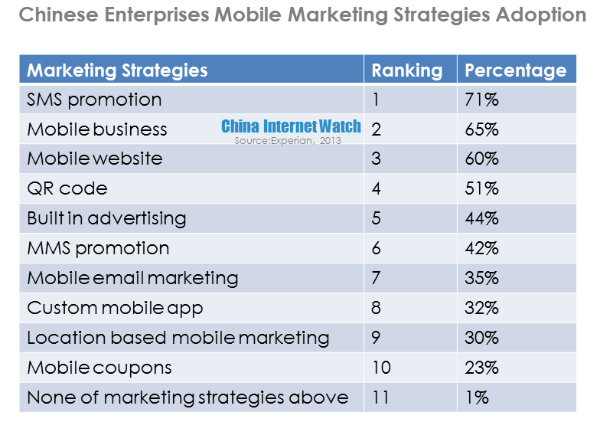
The Coming of Smartphone Age
According to an article published in the Fiscal Times, China’s Smartphone Boom Has Huge Global Impact, the number of Chinese smartphone usage was 330 million, surpassed the total mobile usage number in the U.S.. Experian expected the number would increase to 500 million by the end of 2013.
Mobile services and apps grow along with smartphone users. Tencent’s popular mobile app Wechat had about 400 million users; Baidu and Alibaba both strengthened their mobile app functions.
Most Chinese smartphone users access Internet via mobile, no matter in cities or rural regions, providing a great potential channel for marketing.
However, although China has the highest smartphone penetration, mobile marketing and mobile business haven’t reached their peak yet. Marketers have to improve their understanding of mobile marketing strategies.
Mobile Marketing Adoption in China
Experian investigated 321 enterprises in a variety of industries, and its result showed that China didn’t fall behind to Australia, Singapore and other countries. But enterprises which adopted mobile marketing were not even half of the total. In comparison, 65% of Hongkong enterprises tried mobile marketing, while only 36% of Chinese enterprises tried. Merely 16% enterprises integrated mobile marketing into its strategies.
Mobile marketing seems promising in China, for 92% enterprises agreed that mobile is the most effective way for consumers to know brands.
New Challenge for All Enterprises: Integrated Marketing
The most popular strategies adopted are SMS and MMS, which can reach to consumers directly and quickly. Although mobile marketing grows fast, traditional advertising strategies are still considered to be important. Actually, all enterprises investigated thought all marketing channels became more and more important. Enterprises face challenges not only from integrating mobile marketing into traditional marketing strategies, but also how to analyze data collected from different channels.
Despite that enterprises gradually have learned to collect meaningful data, improvements are still needed. Enterprises need to select data in various ways from a big data pool, getting insights into future consumer behavior.

When asked about top three most popular marketing channels, mail came to number one. 66% of enterprises adopted mail, which demonstrated this traditional strategy would not die out yet. Luxury brands and Real estate enterprises used mail mainly in consideration of reputation. SMS was the second most popular channel, with 61% adoption rate. And email came to the third with 34% rate.
More and more consumers use smartphone to locate shops and compare prices. Some enterprise took advantage and encouraged consumers to go shopping and online shopping, such as L’oreal. But consumers have initiative in how to get access to brands and are in dominant position.

Merely 16% of enterprises integrated mobile marketing to its strategies, 21% tried and 31% made mobile marketing strategies. China mobile marketing wasn’t well developed.
What’s fascinating is, 34% of enterprises which adopted mobile marketing made 11%-25% revenue via mobile channel and 27% of which made 26%-50% revenue. It was almost the same as Hongkong, the reason maybe Chinese used mobile to access Internet more than laptop.
Enterprises have optimistic expectations for revenue driven by mobile marketing. Almost 90% agreed mobile marketing is effective.
Mobile Marketing Strategies
The most common strategies in mobile marketing was obviously SMS, 71% adopted it. Followed by mobile business and mobile website.

Chinese mobile users got used to receiving promotion messages. Phone number was the most important consumer information collected, even more than email address. China banks would send messages with coupons or useful finance news, tips to customers to enhance user loyalty.
In the future, enterprises would probably adopt custom mobile app, mobile coupons and mobile email marketing strategies.